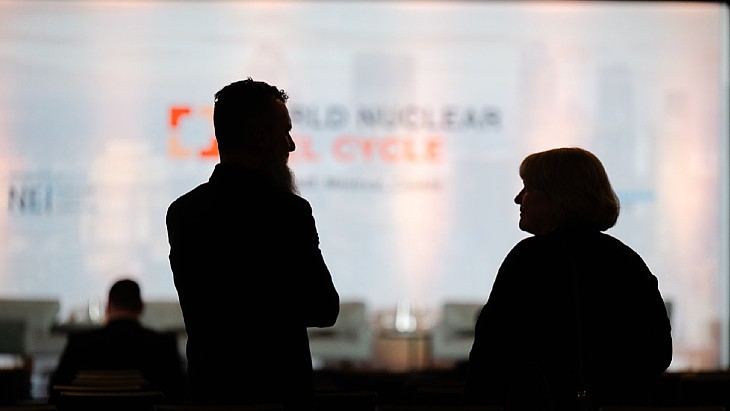BWRX-300 selected for Estonia's first nuclear power plant
.jpg)
In September 2022, Fermi Energia said it would accept tenders from three SMR developers: GE Hitachi, NuScale and Rolls-Royce. Bids with the comprehensive technical documentation needed to estimate the construction cost were expected by December. The company said in the selection of technology, the criteria were technological maturity, the establishment of a reference plant, economic competitiveness and the participation of Estonian companies in the supply chain.
Fermi Energia has now announced the selection of GEH as the winning bidder, and said it will now sign a project development and preliminary works contract.
GEH's BWRX-300 design is a 300 MWe water-cooled, natural circulation SMR with passive safety systems that leverages the design and licensing basis of GEH's ESBWR boiling water reactor. It is currently undergoing a Canadian Nuclear Safety Commission pre-licensing Vendor Design Review and a US Nuclear Regulatory Commission pre-application design review.
"As the initial construction will start in Canada, Fermi Energia saw the reactor as the most suitable for construction in Estonia out of the three offers received," it said. "Based on the design and construction experience of the Darlington nuclear power plant near Toronto, Ontario, the planning, design and construction of the Estonian nuclear power plant can also be gradually started."
"The BWRX-300 is in principle a boiling water reactor, which is used and well known by many European countries, including Finland and Sweden," noted Fermi Energia CEO Kalev Kallemets. "However, the specific reactor model is much smaller than the ones used in the nuclear plants of our northern neighbours, which allows greater safety, lower cost, and shorter build time. At the same time, it is possible to rely on the experience of neighbours and offer the consumer clean electricity at an affordable and stable price."
GEH and Fermi Energia have worked together since 2019 when an agreement was reached to collaborate on potential deployment applications for the BWRX-300. The collaboration advanced in 2021 when the two parties entered into a teaming agreement to work together in key areas that included licensing support and supply chain development.
"We are honoured that our small modular reactor technology has been selected by Fermi Energia to help Estonia fulfill its energy security and climate goals," said GEH President and CEO Jay Wileman. "By leveraging a unique combination of existing fuel, plant simplifications, proven components and a design based on an already licensed reactor, the BWRX-300 offers cost-competitive zero-emission generation in a meaningful timeframe."
GEH noted the technology selection by Fermi Energia is the latest development involving the BWRX-300. Last month, it was announced that GEH, Ontario Power Generation (OPG), SNC-Lavalin and Aecon have signed a contract for the deployment of a BWRX-300 SMR at OPG's Darlington site. In August last year, Tennessee Valley Authority began planning and preliminary licensing for potential deployment of a BWRX-300 at the Clinch River Site in Tennessee. Canada's SaskPower announced in June 2022 that it selected the BWRX-300 for potential deployment in Saskatchewan in the mid-2030s.
In Poland, ORLEN Synthos Green Energy (OSGE) and its partners started the pre-licensing process by submitting an application to Poland's National Atomic Energy Agency for assessment of the BWRX-300. OSGE plans to deploy a fleet of BWRX-300s with the potential for deployment of the first of those units by the end of this decade.
To support the global deployment of the BWRX-300, GEH has a memorandum of understanding or other agreement in place with companies in Canada, Czech Republic, Poland, the UK, the USA and Sweden, among others. GEH has also begun the design certification process for the BWRX-300 in the UK.
"The choice of BWRX-300 by Polish, Swedish and other European companies gives assurance that the competence and supply chain of the selected technology will be sufficient in Europe," Kallemets said.
Fermi Energia noted that, in order to construct a nuclear power plant in Estonia, a decision is needed from the parliament - the Riigikogu - to approve the use of nuclear energy in the country. Also, a special national plan to find a suitable location for the plant must be undertaken, as well as the development of nuclear energy legislation.
"We have analysed all the work ahead and consider it realistic to produce reliable, clean and affordable nuclear energy in Estonia by Christmas 2031, which should also be in the interest of society and the country's climate goals," Kallemets said. "Understandably, this goal requires a serious effort from both the state and Fermi Energia."
Fermi Energia was founded by Estonian energy and nuclear energy professionals to develop deployment of SMRs in Estonia. In July 2019, the company launched a feasibility study on the suitability of SMRs for Estonia's electricity supply and climate goals beyond 2030, following a financing round from investors and shareholders. It selected four SMR designs to be included in the feasibility study: Moltex Energy SSR-W300, Terrestrial Energy IMSR-400, GE Hitachi BWRX-300 and NuScale SMR.
_92619.jpg)

_84504.jpg)







_50521.jpg)

